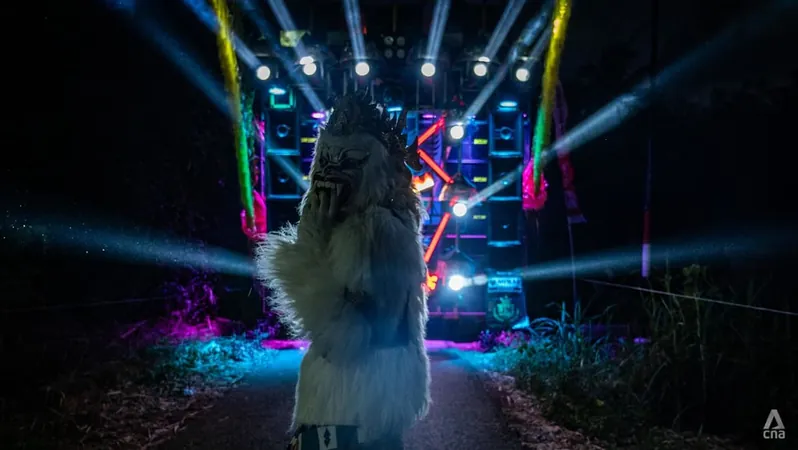
Loud and Proud: The Controversial Sound Horeg Trucks Dividing Indonesia
2025-09-21
Author: Wei
A Clash of Sounds and Sensibilities
MALANG, East Java – The serene farming village of Jeru found itself divided as a convoy of sound horeg trucks, towering and adorned with lights, made its way into town last month. The excitement was palpable among the youth, who eagerly anticipated the annual celebration of Indonesia's Independence Day. Yet, lurking beneath the surface was a brewing storm of tension, as echoes of the thumping bass reached unprecedented levels.
The Sound of Celebration... or Destruction?
For over a year, the villagers scraped together nearly 1 billion rupiah (US$60,000) to hire these colossal mobile entertainment trucks, known for their staggering sound capabilities. It was a dazzling night for some, where the village transformed into a vibrant party scene. "Our village is quiet and boring, but for one night every year, it’s alive," exclaimed Adi, a 19-year-old local.
But while some danced joyfully, others cringed in discomfort as the sound reached 127 decibels—enough to risk permanent hearing damage, according to WHO guidelines. Sound volumes of this magnitude can cause not just discomfort, but also physical damage to properties, leaving many to question whether the celebration has gone too far.
Growing Divisions and Official Edicts
The intensity of sound horeg celebrations has stirred a significant divide within communities in East and Central Java. In response to complaints about noise levels and chaotic behavior at these events, the Indonesian Ulema Council (MUI) declared sound horegs sinful, citing both health risks and moral concerns. Consequently, some municipalities have moved to ban these trucks altogether.
However, in rural areas, where entertainment options are scant, sound horegs continue to thrive, albeit under stricter regulations. New regulations aim to limit the volume to 120 decibels when stationary and 80 decibels while on the move, but enforcement remains inconsistent.
A History of Innovation and Competition
The phenomenon of sound horegs started when villagers sought mobile sound systems for traditional parades in the 1980s. What began as humble pick-up trucks gradually morphed into massive, competition-driven entertainment vehicles. "There is a race to outdo one another in volume, and it’s getting out of hand," noted David, a second-generation sound system provider.
As these trucks became the centerpiece of village celebrations, so too did the pressure to produce louder and more extravagant experiences. The way of life for many sound operators shifted dramatically, with some reporting packed schedules that take them hundreds of kilometers away from home.
Voices Against the Noise: Health Risks and Community Concerns
While the younger generation may revel in the noise, many older residents and health experts raise alarm over the long-term repercussions of such high volumes. Iriana Maharani, an ear specialist, noted that even exposure to volumes of 120 decibels limits safe listening time to just 12 seconds per week.
"Our bodies have limits, and as we age, these limits shrink. There’s potential for permanent damage, and we need to be more careful," she warned, echoing the sentiments of many in the community.
Seeking Balance Amidst Chaos
As authorities grapple with the challenge of managing sound horegs, the recent regulations seem to provide a middle ground. Many operators agree that excessive volume is unnecessary, but the pressure from event organizers often demands otherwise.
The regulations now prohibit loud music when passing hospitals or schools and ban alcohol and inappropriate performances at these festive gatherings. This has been viewed as a positive step by many, including local MUI representatives.
The struggle remains, however, as enforcement continues to lag behind the need. Communities must navigate the fine line between preserving tradition and safeguarding health, illustrating the complexities of culture in a rapidly evolving society.

 Brasil (PT)
Brasil (PT)
 Canada (EN)
Canada (EN)
 Chile (ES)
Chile (ES)
 Česko (CS)
Česko (CS)
 대한민국 (KO)
대한민국 (KO)
 España (ES)
España (ES)
 France (FR)
France (FR)
 Hong Kong (EN)
Hong Kong (EN)
 Italia (IT)
Italia (IT)
 日本 (JA)
日本 (JA)
 Magyarország (HU)
Magyarország (HU)
 Norge (NO)
Norge (NO)
 Polska (PL)
Polska (PL)
 Schweiz (DE)
Schweiz (DE)
 Singapore (EN)
Singapore (EN)
 Sverige (SV)
Sverige (SV)
 Suomi (FI)
Suomi (FI)
 Türkiye (TR)
Türkiye (TR)
 الإمارات العربية المتحدة (AR)
الإمارات العربية المتحدة (AR)